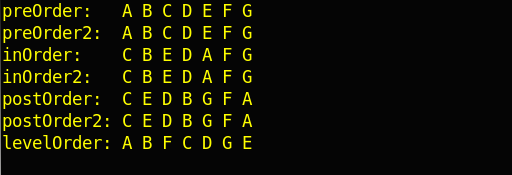二叉树操作
来源:互联网 发布:toastr.js 编辑:程序博客网 时间:2024/05/01 08:27
最近在温习数据结构,把书中的代码写了一遍,下面是二叉树的基本操作,包括:
(1) 四种遍历二叉树的方法: 前序遍历、中序遍历、后序遍历和层序遍历,其中又包括了递归的和非递归;
(2) 两种创建二叉树的方法: 根据二叉树的前序和中序序列创建二叉树和根据二叉树的中序后序序列创建二叉树。
1. 二叉树的存储结构
/* headfiles/BiNode.h*/#ifndef BINODE_H_INCLUDED#define BINODE_H_INCLUDEDtypedef struct BiNode { char data; struct BiNode *lchild, *rchild;}BiNode, *BiList;#endif // BINODE_H_INCLUDED2. 二叉树的遍历
(1)前序、中序和后续的递归算法遍历
递归算法比较简单:
/*sharedSource/preOrder.c*/void preOrder(BiNode *T) { if (T == NULL) return; printf("%c ", T->data); //在此访问为前序遍历 preOrder(T->lchild); //printf("%c ", T->data); //在此访问为中序遍历 preOrder(T->rchild); //printf("%c ", T->data); //在此访问为后序遍历}3. 非递归算法
(1) 前序遍历非递归
/*sharedSource/BiNode.c*/void preOrder2(BiNode *T) //非递归算法前序遍历二叉树{ //initialize the stack BiNode *stack[50]; int top = 0; BiNode *p; p = T; while (p || top > 0) { while (p) { printf("%c ", p->data); stack[top++] = p; p = p->lchild; } if (top > 0) { p = stack[--top]; p = p->rchild; } } //while}(2) 中序遍历非递归
/* sharedSource/inOrder2.c*/void inOrder2(BiNode *T){ //非递归算法中序遍历二叉树 //initialize the stack BiNode *stack[50]; int top = 0; BiNode *p; p = T; while (p || top > 0) { while (p) { //printf("%c ", p->data); stack[top++] = p; p = p->lchild; } if (top > 0) { p = stack[--top]; printf("%c ", p->data); p = p->rchild; } } //while}(3) 后序遍历非递归
/* sharedSource/postOrder2.c */void postOrder2(BiNode *T) { //非递归算法后序遍历二叉树 //initialize the stack BiNode *stack[50]; int top = 0; BiNode *p; p = T; while (p || top > 0) { while (p) { stack[top++] = p; if (p->lchild) p = p->lchild; else p = p->rchild; } if (top > 0) { p = stack[--top]; printf("%c ", p->data); if (top > 0 && stack[top - 1]->rchild != p)//when returned from the right child, //stack[top - 1]->rchild = p p = stack[top - 1]->rchild; else p = NULL; } } //while}(4) 层序遍历非递归
/* sharedSource/levelOrder.c*/void levelOrder(BiNode *T) { //非递归层序遍历二叉树 //initial the queue int N = 50; int front = 0, rear = 0; BiNode *queue[N], *p; if (T == NULL) return; //printf("%c ", T->data); queue[rear] = T; rear = (rear + 1) % N; while (rear != front) { p = queue[front]; front = (front + 1) % N; printf("%c ", p->data); if (p->lchild) { queue[rear] = p->lchild; rear = (rear + 1) % N; } if (p->rchild) { queue[rear] = p->rchild; rear = (rear + 1) % N; } }// while}4. 测试结果
#include <stdio.h>//包含各个文件省略int main(void){ char *pre = "ABCDEFG"; char *in = "CBEDAFG"; char *post = "CEDBGFA"; BiNode *T = NULL; T = createBi_pre_in(pre, in, 0, 0, 7); //T = createBi_in_post(post, in, 6, 6, 7); printf("preOrder: "); preOrder(T); printf("\n"); printf("preOrder2: "); preOrder2(T); printf("\n"); printf("inOrder: ");inOrder(T); printf("\n"); printf("inOrder2: "); inOrder2(T); printf("\n"); printf("postOrder: "); postOrder(T); printf("\n"); printf("postOrder2: "); postOrder2(T); printf("\n"); printf("levelOrder: "); levelOrder(T); printf("\n"); return 0;}输出:

- 二叉树的操作
- 二叉树的操作
- 二叉树的操作
- 二叉树常用操作
- 二叉树的操作
- 二叉树 常见操作
- 二叉树基本操作
- 二叉树相关操作
- 二叉树 基本操作
- 二叉树的操作
- 二叉树基本操作
- 二叉树操作
- 二叉树 一些操作
- 二叉树操作
- 数据结构-二叉树操作
- 二叉树的操作
- 二叉树操作
- 二叉树的操作
- Flowers&&树状数组+离散化
- APUE学习——Ch2.Unix标准化与实现
- 解决strus2中文乱码
- 关于build/envsetup.sh
- 给图片添加阴影
- 二叉树操作
- ffmpeg解码实例
- 基于弹性计算平台——构建高可用、可扩展的应用
- ASP.NET读取ASP设置的Cookie
- 让javascript跑得更快
- #pragma once #ifndef
- struts2.3.3整合spring3.3.1
- VMware虚拟机中双网卡连接双物理网卡的实现
- ipv6 socket


